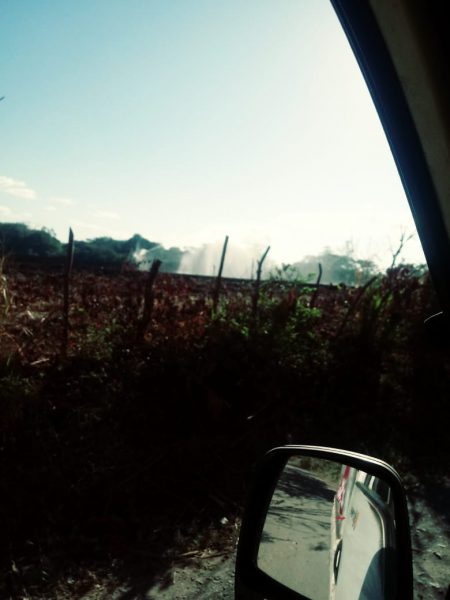Sugarcane cultivation and chronic kidney disease
Sugarcane Cultivation Practices Overview
“The sugarcane itself is not the bad thing. The bad thing is the bad practices of producing sugar that are harming us.”
Commercial sugarcane growing practices in the coastlands of El Salvador negatively impact the lives of the rural communities where these fields lie. Members of the communities in the Bajo Lempa and their allies in the social movement point to three growing practices in particular that negatively impact their health and livelihood: aerial spraying of agrochemicals, burning of the sugar cane before harvest, and depletion of water.
At every step of sugarcane cultivation, agrochemicals are used: fungicides at planting, herbicides and pesticides to control weeds and pests, and fertilizers to encourage growth. All of these agrochemicals affect the health of the workers, the community, and the soil. But the most problematic and the one the communities most fear is the aerial spraying using crop duster planes or helicopters. For the most part, the aerial spraying is of the maturant, usually glyphosate.
When the maturant is sprayed from the air, it doesn’t just fall on the cane fields. The wind carries it to neighboring gardens, where its effects are seen the most in the fruiting vegetables like tomatoes, squash, and chiles; they don’t flower and so don’t produce fruit and wither away. In addition to loss of livelihood and food sources from this practice, farmers who have been learning more sustainable organic practices can lose their organic certification, cutting into their earning capacity still more. And of course, the wind carries the agrochemical into the homes and water supply. It is important to note that worldwide, environmental regulations prohibit application of aerial agrochemicals at wind speeds above 10 mph. Also of note is that the planes arrive with no warning, no way for the workers or community members to prepare and protect themselves.
The zafra, when the cane is burned, occurs in the winter and early spring months. It releases the toxic chemicals that have been applied to the cane into the air. The very hot, very thick smoke is dangerous for children, pregnant women, and small animals both wild and domestic. The people in the communities report respiratory illnesses, asthma, and skin disorders like atopic dermatitis and eczema. The smoke irritates the linings of the nose and throat, and people have symptoms like those associated with allergies, as well as nosebleeds. The high-intensity burns also contribute to the depletion of the soils where the cane is grown, further damaging biodiversity and the ecosystem.
Burning of cane is a quick and easy way to facilitate harvesting, but it is not a necessary step in the process. You can just cut the green cane. Known as zafra verde, this practice is better for the land and the people. There is a law on the books that could be applied to this practice as well, but it is not enforced. What is a higher priority for the business interests and the government is that the industry fulfills its escalating quotas of sugar sold to Chinese and U.S. markets per the free trade agreements.
Cultivation of sugarcane requires massive amounts of water. As a result, the water tables in the Bajo Lempa have fallen dramatically in recent years, limiting the amount of water available for other uses. Small farmers in the Bajo Lempa grow traditional crops–corn, beans, sorghum, and vegetables–in the rainy season, from May to November. But due to climate change, they have been suffering through periodic drought conditions and find that there is not sufficient water in the aquifers to water those crops.
In addition, pumping water from the rivers affects the entire ecosystem in the area. Because so much water is removed from these tidal rivers close to the coastline, the lower flow in the rivers causes the salt line to move further inland, producing salinization of the water sources.

The CKD Epidemic
“It provides work for people, but we pay with these illnesses.”
Besides concerning respiratory illnesses that harm the lives of the residents of the sugar cane growing communities, another illness has reached epidemic proportions in the region: chronic kidney disease, or CKD. Kidney failure has become the leading cause of in-hospital death in El Salvador.
In the developed world, CKD is linked to high blood pressure and diabetes, illnesses which themselves put stress on the kidneys. But 30% of cases in El Salvador have no such comorbid conditions. That means that 1 in 3 patients with CKD in ES have contracted the disease in some other way. Dr. Carlos Manuel Orantes Navarro, a Salvadoran nephrologist currently head of the department of the Kidney Health Research Unit of the National Institute of Health of El Salvador, who has conducted epidemiologic studies in the Bajo Lempa region, has concluded that those causes include lack of protection from exposure to agrochemicals, both in the fields and in the communities, as well as dehydration from the conditions of working in the intense heat without access to fresh water. So one element contributing to the epidemic is climate change. The rise in average temperatures has been incremental in Central America, but the number of extremely hot days has gone up disproportionately. This can put even experienced workers in the field at risk of dehydration, which exacerbates the effects of the chemical exposure (by concentrating the urine).
The incidence of CKD has been rising in El Salvador over the past 20 years (coinciding with the boom in sugar cane agribusiness). The health units in the Bajo Lempa have the highest prevalence of CKD in the nation. Up to 25% of the nearly 20,000 inhabitants of the Bajo Lempa have CKD. In 2019, 5,133 patients were diagnosed with stage 5 CKD (requiring renal support), according to the Ministry of Health Operational Plan assessment; of those cases, only 10% (544) had access to renal dialysis of any form. Poverty impacts these folks because they cannot afford the dialysis. Even the transport costs to and from the city to receive hemodialysis are beyond their means in many cases. One estimate is that easily 1 in 4 patients who DO receive dialysis are only able to do so because of remittances sent by family members living abroad.
Because CKD is asymptomatic in early stages, there is little warning that they are suffering such damage until it is far advanced. In early stages, the falling potassium levels and the rising uric acid levels can be managed with medications and diet. Early diagnosis and treatment can keep end-stage kidney disease at bay for decades. Later stages require dialysis, either hemodialysis, which must be done at a hospital or dialysis center, or peritoneal dialysis, which can be done at home in a clean environment. Very few Salvadorans have access to kidney transplants.
A final complication: COVID19. Dr. Orantes notes that patients with CKD are at increased risk of serious infection with COVID, as failing kidneys and improper dialysis compromise their immune systems. Because of the risk of COVID, medical consultations for CKD patients have been suspended. The ES government does not want these patients traveling to hospitals at this time, where there is a danger of COVID contagion due to long waits. But confining them to homes that cannot be made sterile or safe for them is dangerous. Although the government hopes to provide the patients with the proper supplies to perform peritoneal dialysis at home, how can cleanliness be guaranteed in poor rural communities, without adequate access to clean water? Both COVID and CKD share one health recommendation: frequent, rigorous handwashing. But in some communities, at least 1 in 4 houses have only sporadic access to clean water.
Annotated bibliography
Link to blog post including Lance Laver’s 2015 analysis of the situation
U.S – El Salvador Sister Cities. Mario Guevara. Blog post. The Changes We Want from the Sugarcane Industry. 18 November 2019. https://www.elsalvadorsolidarity.org/the-changes-we-want-from-the-sugarcane-industry/
Link to article about COVID19 and CKD in Jiquilisco, Usatlán. This article has a lot of background information about the CKD crisis in El Salvador, and highlights the complications imposed by the stay at home orders for those dependent on dialysis.
Girón, Glenda. Two diseases on a deathly collision course: A story of Jiquilisco, Usatlán. Séptimo Sentido. La Prensa Gráfica. 26 April 2020. https://7s.laprensagrafica.com/en/las-dos-pandemias-que-se-cruzan-en-jiquilisco/
Link to slide presentation of Dr. Orantes’ findings, where he shows how this illness differs from other forms of chronic kidney disease, discusses the devastating effect it is having in El Salvador, and defines it as a pandemic
Orantes Navarro, Carlos Manuel. Harvard Medical School Renal Grand Round. Slide presentation. Chronic Interstitial Nephritis in Agricultural Communities (CINAC): Nephrological Challenges of an Epidemic. nd. https://docs.google.com/presentation/d/1e_phNzOiFIR6BHNqS8HzKDMff94tvatCae5zT2NWjPA/edit#slide=id.p1
Link to a 2019 paper by Dr. Orantes that finds that CKD is an “epidemic of massive and unprecedented proportions in El Salvador”
Orantes Navarro, Carlos Manuel. The chronic kidney disease epidemic in El Salvador: A cross-sectional study. MEDICC Review, April–July 2019, Vol 21 (2–3): 29-37. https://mediccreview.org/wp-content/uploads/2019/07/MR-AprilJuly2019-OR-orantes-chronic-kidney.pdf
Link to Report of the Exec. Committee of the Pan-American Health Org, with info from Dr. Orantes and more info about the scope of the problem.
Pan-American Health Organization. WHO. Report of the 164th session of the Executive Committee. Chronic Kidney Disease in Agricultural Communities in Central America: Progress Report. 10 June 2019. https://www.paho.org/hq/index.php?option=com_docman&view=download&alias=49119-ce164-inf-7-c-e-kidney-disease&category_slug=164-executive-committee&Itemid=270&lang=en
Link to the video of burning of the fields. There is also a short video of a crop duster plane included.
U.S – El Salvador Sister Cities.Youtube video. Bad Practices in the Sugarcane Plantations of El Salvador. 28 August 2018. https://www.youtube.com/watch?v=44o-CfFLzQI&list=PLSQO1PvekMouNSGDSrMOaRgsm9ru2WOCY&index=2
Link to The Bittersweet Flavor video, which includes interviews with farmers, videos of cane fields in Las Anonas and of a conference on cane production and food sovereignty, with interviews from representatives of the social movement
U.S – El Salvador Sister Cities. Youtube video. The Bittersweet Flavor of Sugarcane Production for Salvadorans. 1 October 2016. https://www.youtube.com/watch?v=mXtjdJyZgk0&list=PLSQO1PvekMouNSGDSrMOaRgsm9ru2WOCY&index=1
Link to the short video of the helicopter spraying in Las Anonas, San Vicente
U.S – El Salvador Sister Cities. Youtube Video. Helicopter Spraying in San Vincente. 23 January 2019. https://www.youtube.com/watch?v=T5VzcLVtsZI&list=PLSQO1PvekMouNSGDSrMOaRgsm9ru2WOCY&index=6
Link to the video showing effect of maturants on other plants. The plantain trees the farmers grow are affected by the spraying of the maturant. This video was taken 8 days after spraying.
U.S – El Salvador Sister Cities. Youtube video. Quimicos afectan plantaciones del bajo Lempa. 26 December 2018. https://www.youtube.com/watch?v=i0CTT7u9AlA&list=PLSQO1PvekMouNSGDSrMOaRgsm9ru2WOCY&index=5
Link to video showing the effects of removing water from the Rio Lempa, showing the large pumps. Interviews with numerous members of communities and the social movements. Also includes a video of burning of the cane in San Carlos.
TeleSUR TV. Youtube video. El Salvador: actividad de la industria cañera genera crisis hídrica. 4 February 2020. https://www.youtube.com/watch?v=tQKCzcQi6kM&list=PLSQO1PvekMouNSGDSrMOaRgsm9ru2WOCY&index=7
Link to the Voices on the Border summary, which goes into great detail about all aspects of this problem, including detailed analysis of the effects of neoliberal policies and in-depth description of the many agrochemicals used in the cultivation of cane
Voices on the Border. Report: Large-Scale Production of Sugarcane in El Salvador. March 2016. Online at https://voiceselsalvador.files.wordpress.com/2016/05/large-scale-sugarcane-production-in-el-salvador.pdf
